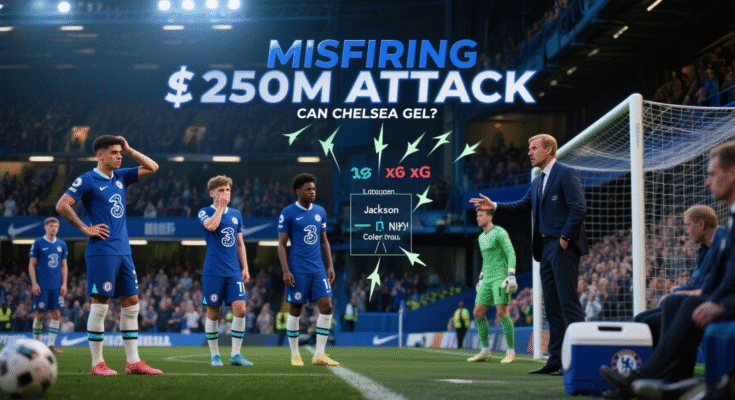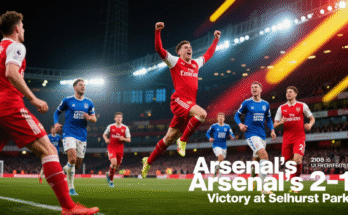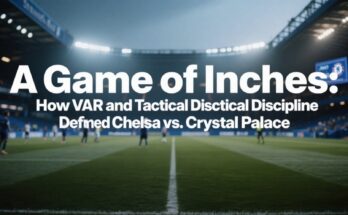There is an existing optimism through Stamford Bridge during the start of a new season that has captured the feeling of excitement with a hint of desperation at its core as well. As we can see the attack is obviously not performing at its quarter-of-a-billion-pounds price point, the big question is whether or not it is time to panic. There is a more subtle view that it is way too soon to come to such authoritative conclusion. It is only in August yet. It may unrealistic to expect a newly formed, multi-national forward line to show that it can get along immediately with in a perfect chemistry. The wasted opportunities are without a doubt a justified complaint, but the latter seems to be based more in problems of confidence and unity than a core lack of talent. The only real test of success on this attack will not be its record out at present, but the fact that the same trouble will continue on into the winter months. Time will tell, but it seems, right now, to be a textbook case of a talented team requiring time to gel, though the heat is already starting to be turned up on the manager to force this along quicker.
Anatomy of the Issue: What a Misfiring Attack Looks Like
In order to comprehend the scope of the problem, one should go beyond a mere fact of the unachieved goals and evaluate the on the pitch evidence. The occurrence of a misfiring attack presents numerous observable and different ways that imply cumulative effects that the team fails to bring its strength to bottlenecks and win. These are not coincidence mistakes but rather the cyclical issues that indicate a root cause of the bigger problem that should be fixed.
First of all, it is the visible absence of clinical finishing. The players have successfully navigated themselves into good positions only to fail at the last minute. This can be seen when shots are pulled wide of the post, ballooned over the crossbar, or targeted straight at the goalkeeper and thus saves are not hard to come by. This inability to challenge the opposition goalkeeper sufficiently on a regular basis is an indication of a lack of both technique when pressurize and a large component of lacking composure.
Poor Decision-Making and Lack of Attacking Cohesion
On top of this is less than optimal decision-making in the last third. Many times, a mark who has a clear shot will choose to shot from a bad, tight angle but it could have had an excellent shot option opening it up to a lesser positioned teammate and thus an improved chance. Such a tendency is indicative of a loss of tactical awareness and an individual birth mentality in which the players are doing too much attempting to become the hero and instead focus on optimizing the overall score of the team. This cuts off the main striker and causes attacks that have potential to be developed to almost halt.
Likewise, an absence of chemistry or the feel of things can be noticed. There is a distinct lack of the complex interrelationships which characterize elite forward lines. One player will fly in with a incisive run and the pass will be late or back into the incorrect space. A midfielder on the other hand will fire a creative through-ball, only to have his intended runner miss his mark. This breakdown does not allow the attack sequence to flow as it should and it will instead seem staggered and hasteful and any quick fluid motion needed to put an out of position defence off balance would be lacking.
Statistical Deep Dive: The Data Behind the Disappointment
Currently we can put numbers to these observations in football analysis and in the case of Chelsea the numbers bear out the eye test. The statistics data tells that the team is doing great within the two penalty boxes and dreadfully within them.
Key Stat: Shots vs. Shots on Target
This is probably the most penalizing statistic and the most significant piece of evidence that shows that Chelsea is not worth its salt. A usual shot summary of the team in recent matches is as follows:
- Total Shots: 19
- Shots on Target: 3
This is a radical difference. Trying to make 19 shots toward the net is quite an amount of action in terms of territory possession and generating chances. But, to deny the opposition keeper with only three saves out of those attempts is a very big waste. It demonstrates that most of the actions of Chelsea do not even come close to challenging the goal, indicating a critical problem of accuracy and finishing quality.
| Chelsea’s Attacking Expenditure | Player | Approx. Transfer Fee |
| Central Midfield (Attacking) | Enzo Fernández | £106.8 million |
| Winger | Mykhailo Mudryk | £88.5 million |
| Striker | Nicolas Jackson | £32 million |
| Winger | Noni Madueke | £29 million |
| Attacking Midfielder | Cole Palmer | £42.5 million |
| Partial Total | ~£298.8 million |
Understanding Expected Goals (xG)
A better understanding is given in the so-called Expected Goals. Simply put, xG is a statistical measure that attributes a probability rating to each shot depending on its possibility of leading to a goal factoring in things such as distance and angle as well as defensive pressure. A high xG situation is a tap-in at a close range (e.g. 0.9) whereas a very low xG situation is a far-range shot (e.g. 0.02).
As their xG data shows, Chelsea have one of the more decent total xG, which in many cases is amassed by the significant number of low-quality opportunities. Their xG per shot is heavily below average and this shows that they are not getting clear-cut chances. The implication here is a tactical problem in penetrating the last line of defence to enter high likelihood areas of scoring.
Diganosing the Cause: Chemistry and Tactical Challenges
The causes of the problems that plagued this costly assault are complex, related to the issue of interpersonal behavior as well as strategic challenges.
The Chemistry Conundrum
The foundation of attack playing football by the elite teams is comprehension and trust which can not be purchased, but has to be constructed through the ages. Chelsea has gone through massive turnover with most of bigger attackers new in the side.
- Forging bonds: It takes attackers hundreds of hours on the training pitch and in competitive matches to build the telepathic connection that enables them to receive and distribute the ball in the most efficient way. This is a yet developing process of relationship building.
- The pressure of the value of the price tag: The huge transfer fees involving these players impose a massive external pressure to perform instantly. This may result in nervousness in threat of goal resulting in players pouncing on opportunities as opposed to the composure which characterizes the best finishers.
The Tactical Challenge: The “Low Block”
Low block is a typical issue of possession-based teams, and the given strategic problem is common to Chelsea. The majority of the opponents do not play straight forward attacking games against Chelsea.
What is the Low Block? It is a defensive tactic, in which a team defends very deep in its own half and the ball is behind ten outfield players. This forms a dense tight defensive form, and reduces the room left to the attacking team.
Neutralizing Strengths: The low block is specifically to counter the threat of fast forwards by depriving them space to run in behind the defence. It leaves the attacking team with intricate, creative passing in close areas as the only method of finding a breach a practice that is especially challenging to a team building its chemistry.
A Time for Concern or a Call for Calm?
This is the main controversy about the club there are strong arguments against and in favor of the club.
The Argument for Concern
The early struggles can and should be played down by citing valid grounds, which point out that there is something behind it all. Unable to break down a well organized and defensive team is not new to Chelsea; it was one of their issues. Moreover, losing points in matches that they can and should win at this early in the season can be very costly in a title-chasing season where the others are adding the pressure on the pedal. Last but not least, confidence is a precarious quality to take shots in; a goal dry spell might eventually turn into a psychological problem which will be hard to overcome.
The Argument for Patience
On the contrary, the argument of relaxation is just as strong, if not stronger. This is mainly due to time as this is only August 17, 2025. The season is an endurance event not a race and there are still lots of time to fix these problems. The team is extremely young, and it is quite natural that a newly formed team that consists of players of other leagues and cultures should need a few months to become properly integrated and be able to establish cohesion. The talent of the individual in the team cannot be disputed. Thus, the problem is not so much whether or not this potential will materialise but as to when.
| Key Attacking Metrics (Early Season) | Chelsea | League Average (Approx.) | Top Performing Teams (Approx.) |
| Shot Conversion Rate | Low | Moderate | High |
| Shots on Target % | Low | Moderate | High |
| Expected Goals (xG) per 90 mins | Moderate | Moderate | High |
| xG per Shot | Low | Moderate | High |
Verdict and Forward Outlook
Finally, the low standards of the attacking play of Chelsea have been rightly criticized; one needs to put the performance into perspective, though. The problems on the pitch namely of the lost finishing and the wrong decision making process as well as a lack of chemistry cannot be disputed and these can be seen in the data. But these are the posed characteristics of a new team emerging that is still in the building stage to identify and have an understanding. One of the major challenges that the manager is presented with is to shape a group of very costly persons into a close-knit and productive team.
It is not the lack of talent that is of immediate concern but instead finding ways of tactically breaking down their sturdy low-block defences they will go up against much of the season. It is how they react to it in the remaining months that will legitimately measure this team and not their performance in August. Should such inefficiencies continue into the months of November and December, then the inefficiencies that plagued the team early in the season will have turned into a full-blown crisis. As of now, the position requires patience and being trusting of the machinery but the clock is already striking.
My Opinion
Although the £ 250M attack is a huge investment, the poorly mounted attack by Chelsea is the cause of great concern. The absence of an end product in the third third points out the problem of not only finishing but also decision making. There is that individual talent, but when there are no chemistry and comprehension then the attack lacks a sense of cohesiveness. This has been their weakness which has been repeatedly exploited by opponents who sit in low blocks. Chelsea are at risk of failing to change unless they can improve their cohesion meaning another mixed and infuriating season is likely.





Insightful review. A lack of coherence and poise in the final third is the overwhelming characteristic of Chelsea 250M line of forward. Until chemistry is better there would be an inconsistency in the results.